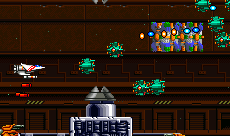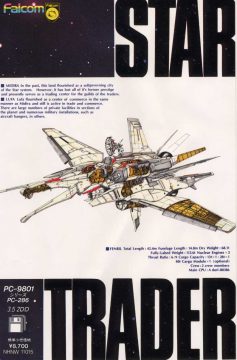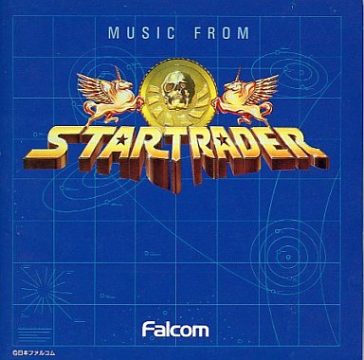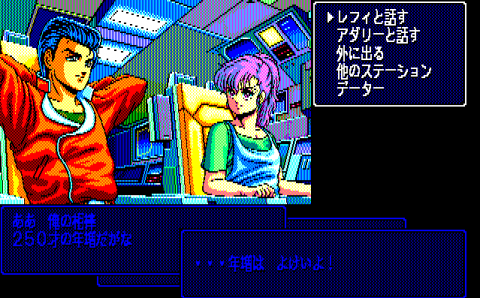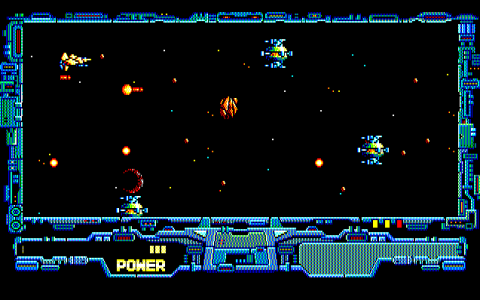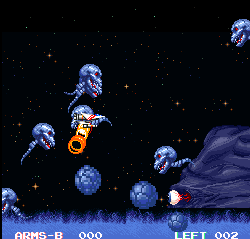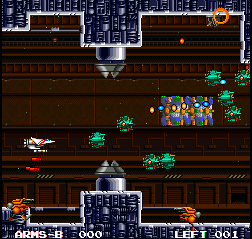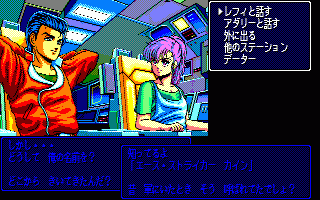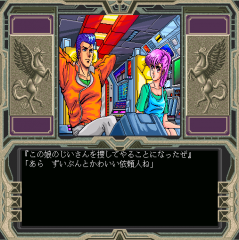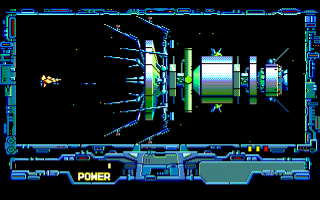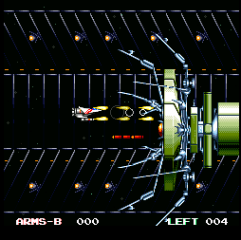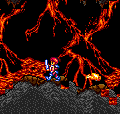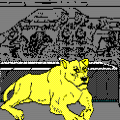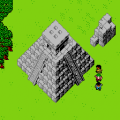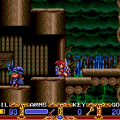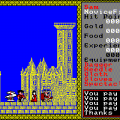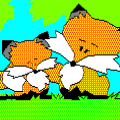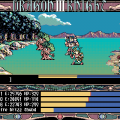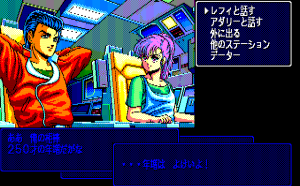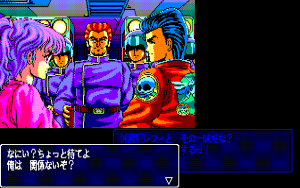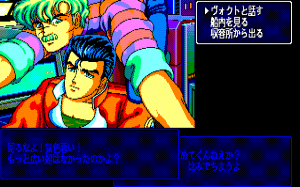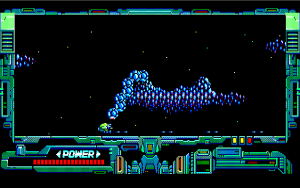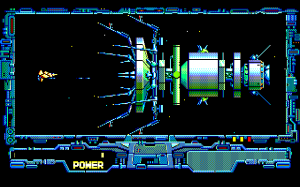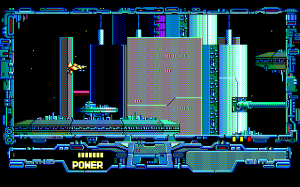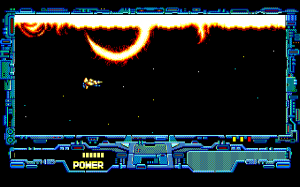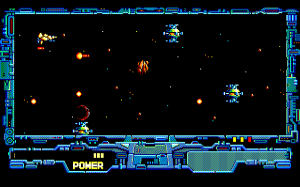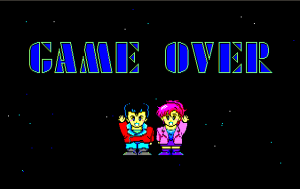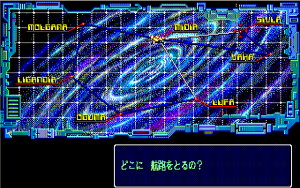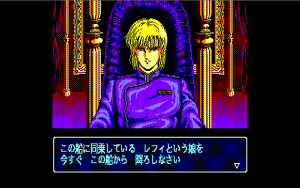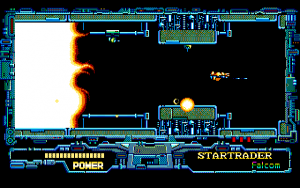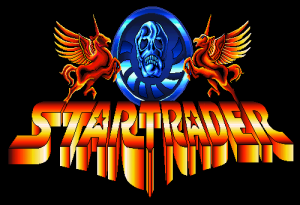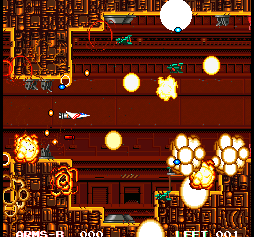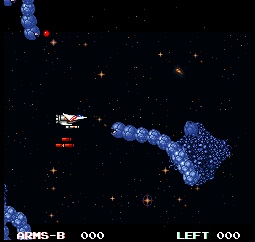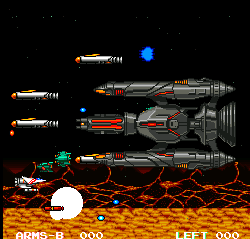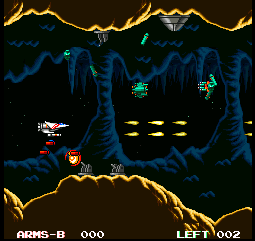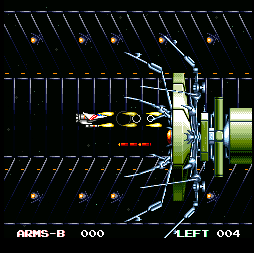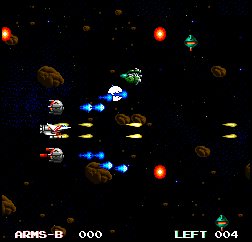Initially released on the PC88, Star Trader combines elements of an adventure game with shoot-em-up segments. As ace pilot Kain, you’re approached by a young girl named Lefi, who has some kind of mysterious seal. I’m lost about the rest of the plot, but it’s your job to fly around the star system and uncover whatever mysteries need to be solved. As you reach new space stations, you’re granted more money, which in turn can be used to buy new weapons for your ship.
The adventure segments are pretty straightforward, as you pretty much just choose to talk to your ship or your compatriot, check out the shop, and then choose your next destination. You rarely get to explore on your own (and usually get met with a response like “there’s no reason to go there” if try to head to different star systems) but the game isn’t completely linear. For instance, if you choose to accept a job at the beginning of the game, you start off heading towards a completely different star system. You’ll also end up finding new allies and occasionally piloting different starships. Considering that most shoot-em-ups only feature their characters in the intro and ending cinemas, the story and dialogue crammed into Star Trader make the game stand out in a genre that, in the late 80s, was cluttered with practically identical clones.
The tragic flaw of Star Trader is that the actual shoot-em-up segments are really, really bad.
Whenever you fly between space station, you get to play an action scene. The PC88 wasn’t exactly a graphical powerhouse, so the scrolling is choppy and distracting. But that’s only a minor issue – the bigger problem are the annoyingly aggressive enemies. They come from all sides, without warning, unleashing torrents of minuscule bullets or even careening straight into your ship for a kamikaze attack.
There are many instances where it’s pretty impossible to get through segments without getting hit. While technically you can sustain a lot of damage, there’s no invincibility time, so hitting a solid object will destroy your ship practically on impact. The near useless weapons don’t help matters either. And once you beat a segment, you can’t just skip it if you want to return back to the originating space station. Instead, you’ll need to fly the same level, except scrolling from right to left, essentially making you replay the levels in reverse. The levels usually aren’t too long – maybe a few minutes – but having to repeat them over and over and over due to the massively unfair difficulty sucks the fun right out of Star Trader.
There are also some parallels between this game and Namco/Wayforward’s Sigma Star Saga, which despite being published over fifteen later years for the Game Boy Advance, suffers from the same basic flaw – an innovative framework for a shoot-em-up unfortunately ruined by the actual shooter segments.
Someone somewhere must’ve realized this. Another publisher, Takeru, ported the game in 1991 to the Sharp X68000 and gave it a massive overhaul. All of the adventure elements were ditched, with only a handful of cutscenes surviving, but the actual shooting segments have been much improved. The X68000 is a far more powerful computer than the PC88 ever was, at least when it comes to graphical hardware, so the graphics look and move much better, easily matching the quality of many 16-bit home shooters (and even some arcade ones.) You still have the vulcan cannon and missiles, so it now feels a lot like Darius. You can only take one hit but are now granted three lives – however, the game isn’t too terribly hard, and at only seven stages long, it won’t take long to see this one to the finale.
Since you can no longer buy power-ups, you instead obtain them from capsules in the level, much like any standard game, which grant you more powerful attacks for a limited amount of time. The names and designs of many of the stages, as well as the music, have made the transition, even if they’re not all exactly the same. Many of the bosses are identical as well, although obviously they look superior. Even though the most innovative part of the game was trashed, the X68000 version is ultimately a better experience – even though there’s really nothing really special about it, at least it’s a solid game.
Most Falcom games have excellent soundtracks. Star Trader isn’t exactly one of them. There are a few good songs – particularly the “Go Fight” song, which has some cool arrangements found on various Falcom CDs – but overall there’s nothing too special here. And despite its unique premise, Star Trader never quite shakes off the fact that it’s walking in the footsteps of the better shoot-em-up that inspired it – heck, many of the levels and some of the enemies are blatant rip-offs of Salamander and Gradius. Throughout the years, Falcom has re-released and upgraded many of its games for newer systems, but has left Star Trader untouched. While it’s easy to see why it’s been ignored, if they updated the adventure segments of the PC88 version and combined them with the shooting segments of the X68000 version, you’d have a fantastic game.
Screenshot Comparisons
Screenshot Comparisons
